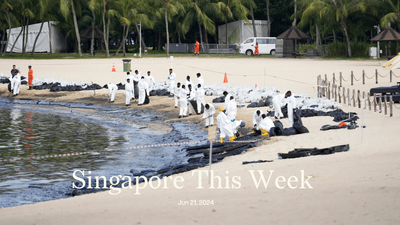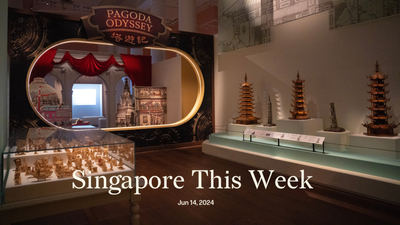Politics: A feisty day in Parliament under the eyes of a new speaker
“No need to bang on the rostrum,” Seah Kian Peng, the new speaker, admonished Leong Mun Wai, non-constituency member of Parliament (MP) with the Progress Singapore Party, after the latter twice knocked the rostrum. Leong was objecting to statements from Murali Pillai, MP with the ruling People’s Action Party (PAP), which Leong believed suggested that he’s in favour of rent control, in a debate on the Lease Agreements for Retail Premises Bill. Murali denied saying that. It was Seah’s first experience as speaker of a now well-established parliamentary ritual: Leong complaining, not without merit, about “the same pattern” of PAP MPs labelling him. (“Strong racist and xenophobic undertones” they’d said in a previous debate on foreign talent.) Proceedings were dominated by the ongoing inquisitions into a slew of scandals, in and out of the bedroom, that have hit the PAP and the Workers’ Party (WP). Pritam Singh, the WP’s leader, referenced what many Singaporeans believe has been the delayed release of information over a number of issues: the Ridout Road saga, the arrest of minister S Iswaran, and the TraceTogether data sharing debacle. He alleged that “the PAP [had been] engaging in half-truths on matters of significant public interest,” and said that the government should consider appointing an ethics advisor. Lee Hsieng Loong, the prime minister, argued that procedure had been followed on all three, including the fact that ongoing investigations by the Corrupt Practices Investigation Bureau (CPIB) are often not initially disclosed: “In terms of transmission of information, we are pursuing a red herring.” In questioning the PAP’s handling of the extramarital affair involving Tan Chuan-Jin, the previous speaker, Singh’s decision to reference the saga over Raeesah Khan, former WP MP, appears less wise. He was immediately forced on the backfoot over his use of the word “rape”, not only in Parliament but subsequently on social media by Khan’s former aides. While the WP might understandably feel aggrieved by many aspects of RaeesahGate, it was a reminder that marshalling it is a double-edged sword. On the extramarital affair, Lee said that he “should have forced the issue sooner.” It was a rare admission by a leader who must miss the days of boring Singapore politics. For many observers, with popcorn out for a Wednesday afternoon livestream, it was another sign that parliamentary debates are maturing.
Politics: RidoutGate touches Lee Hsien Yang and The Economist
Lee Hsien Yang joined the infamous POFMA club last week over Facebook comments about the Ridout Road bungalow leases by ministers Vivian Balakrishnan and K Shanmugam. After adhering to the correction order, he went on to dispute it. The ministers then threatened to sue him for the alleged “defamatory statements”—that they acted corruptly or for personal gain in the episode—unless he apologises, withdraws the supposed allegations, and pays damages that they’ll donate to charity. Lee denied making those allegations, and said that since his post was made in the UK, they should sue him there. Given that Lee has dug in his heels, it seems only a matter of time before legal action is taken—most likely in Singapore, as lawyer Suresh Damodara and law professor Eugene Tan told Mothership. Lee’s father, Lee Kuan Yew, sued all manner of critics, from opposition politicians to international magazines, for defamation during his tenure, sometimes bankrupting them. That the ultimate weapon may now be wielded by his disciples against his own son is perhaps the greatest indication of the bizarre political funk in which Singapore finds itself. Separately, another UK-based irritation for the government emerged last week in the form of an editorial in The Economist, “A slew of scandals puts Singapore’s government on the back foot”. Its central argument is that “...if internal checks cannot ensure spotlessness and a steady hand, there is good reason to add external ones.” Several suggestions drew the ire of the government, including: “Reporting to the prime minister, who appoints its head, the CPIB cannot be fully independent.” Lim Thuan Kuan, Singapore’s high commissioner to the UK, wrote a scathing letter to The Economist, in which he asked: “Would The Economist suggest that the head of Scotland Yard is not independent because he is appointed on the advice of the UK Home Secretary, in consultation with the Mayor of London?” What should please the Singapore government is that The Economist explained “ownself check ownself” to an international audience. This will help with the promotion of Brand Singapore: autocrats everywhere, avid fans of the late Lee, will now be translating it for their local contexts.
Society: No end to ferrying workers by lorry, says government, pleasing businesses
In a shameful joint statement on Tuesday, 25 business bodies said that if Singapore sought to end the transportation of workers in the backs of lorries, it would lead to “real, practical and operational complexities.” They were responding to two calls by activist groups last week to end this cruel practice, themselves prompted by recent lorry accidents involving 37 workers. The business groups, including the Association of Small and Medium Enterprises, issued a series of thinly veiled threats. One is that a shift to another mode of transport would lead to greater traffic congestion—nonsensical, if one considers that air-conditioned double-decker buses occupy less road space per worker than lorries. Another “challenge” cited is increased “commuter congestion”, which may play on bigoted fears about an invasion of brown workers on buses and trains. Most ludicrous of all is the notion that an end to this practice would actually harm workers themselves, by “...risking the livelihoods of workers who depend on these industries for their employment.” Read: sacrifice yourself in lorries, or sacrifice your jobs. “They are resorting to scare tactics to support their cause…,” said Tommy Koh, Singapore’s ambassador-at-large, on Facebook. “The real reason for their opposition is money.” Yet just a day after their statement, the government, while admitting that the situation is “not ideal”, echoed their view: “If the companies are unable to operate their business, there will be knock-on effects on society, including delays affecting new housing projects, polyclinics and MRT lines; as well as higher costs for all Singaporeans.” So, there will be no change, and Singapore will continue, in Koh’s words, to have “the dubious distinction of being the only wealthy country” to allow this practice. Safety measures throughout history, from seat belts to food handling requirements, have resulted in higher costs that society accepts and shares. Surely the government can help subsidise this transition, as activists have suggested. Firms scraping by in an inflationary environment will exploit workers as long as they can. In the elegant formulation of one Redditor: “Dead cheap labour: I sleep; Reduced profit margins: Real shit.”
Society: ‘I work best with mentally stable men and women’
The share of resident job seekers facing discrimination based on mental health conditions increased dramatically from 2.9 percent in 2021 to 5 percent in 2022, according to the latest Fair Employment Practices report by the Ministry of Manpower (MOM). Discrimination based on race, religion, and family status all rose slightly, while those based on age, sex and nationality declined. Job search discrimination can include advertisements that state a preference for a specific demographic without justification or employers that ask for irrelevant personal information. In some instances, even an employer’s LinkedIn profile could reflect discriminatory attitudes, as in the case of comms professional Satwant Kaur (Jom wrote about her viral “HDB people” post in a previous “Singapore This Week”) whose (now deleted) bio read “I work best with mentally stable men and women”. Mental health discrimination is now the third most common form of discrimination during the job search process, after age (16.6 percent in 2022) and race (7.1 percent), and is more prevalent than sex (4.2 percent) and nationality (4 percent). Things aren’t much better in the workplace. Prejudice against employees with mental health conditions ranks first, experienced by 4.7 percent of respondents, ahead of all other forms of discrimination. MOM said these findings could be due to the expectation for employers to care for their employees’ mental needs (for example, via extra medical benefits or medical leave), as well as an overall increase in the proportion of people with mental health conditions in the labour force: 13.4 percent of residents aged 18 to 74 reported poor mental health in 2020 compared to 12.5 percent in 2017. Though MOM didn’t reveal how exactly those with mental health conditions were discriminated against, common forms internationally include unjust termination, denial to medical resources and bullying. Encouragingly, more employees have reported stronger, more formal procedures implemented to manage workplace discrimination (59.8 percent in 2022 compared to 54 percent in 2021). Hopefully, these procedures will help counter commonly cited concerns that discourage workers from seeking help, such as a “fear of being marginalised” or experiencing “repercussions on [their] career”.
Earth: Search for ‘green electrons’ imports not dampened by Indonesia’s flip-flop
Singapore continues to scour the region for green electricity imports, in order to meet its target of net-zero carbon emissions by 2050. (Options for generating renewables domestically are limited.) But what if the exporting country also needs those clean sources to meet its own climate change commitments? How does one assess fair trade and exploitation in the international green energy markets? These questions have come to the fore after an article in the South China Morning Post detailed Indonesia’s apparent flip-flopping on the issue. Last year, Indonesia banned green energy exports, apparently shocking some Singaporean firms that had already agreed deals to import renewable energy from there. Despite the ban, this March, Indonesia and Singapore signed a memorandum of understanding on renewable-energy cooperation, seeking to strengthen the energy infrastructure, transition and security in both countries. In May, Luhut Binsar Pandjaitan, Indonesia’s minister of maritime affairs and investment, appeared to reaffirm the ban, when he suggested that Singapore build renewable components factories in the country if it wanted the suspension fully lifted: “...until we see factories being built or plans finalised, it might be hard to feel a sense of assurance or stability.” Experts said Indonesia wants to see trade partners add more value to its domestic industries, in many ways the continuation of a long-standing (and not unreasonable) worry about exploitation by richer powers. “Exporting green power does not contribute towards Indonesia’s climate goals, only Singapore’s,” said Fabby Tumiwa, executive director at Jakarta-based think-tank Institute for Essential Services Reform. “How can Indonesia benefit?” It’s a fair question. Indonesia must strike a balance between export revenues and catering to its domestic needs. In an earlier interview with The Jakarta Post, Fabby had warned that red tape might cause Indonesia to “lose the opportunity to dominate the [Singapore] market.” From Singapore’s perspective, while it’s cheaper and easier to import green electricity from its immediate neighbours, Malaysia and Indonesia, it also doesn’t want to become overly-reliant on potentially unreliable sources. We already buy renewable energy from Laos and Malaysia, and are also looking to Australia, Thailand, Vietnam and Cambodia, among others. Sustainable trade in what Singapore calls “green electrons” is still some way off.
History weekly by Faris Joraimi
Panggilan Anak Pulau (“Call of the Island Descendants”), held at The Projector last Sunday, marks a significant step in public remembrances of the Singapore Southern Islanders’ removal from their homes during the republic’s relentless industrialisation of the 1970s and 1980s. Some 250 attendees, of whom more than a hundred were either descendants of, or islanders who had grown up in the Singapore Strait, sat for academic panels, anecdote-sharing and music performances. Organiser Firdaus Sani, of heritage and food outfit “Orang Laut SG”, said that this is the first autonomously coordinated event commemorating the islanders’ histories, compared to those before led by researchers from outside the community (however important those were). Occupying a place of honour, the islanders were seated at the massive theatre’s front rows, their laughter and chatter a welcome change from the usual atmosphere at heritage events attended by intellectuals and activists. It was hosted by Syurga Jeffrey, a teenage descendant of Pulau Sudong and daughter of seasoned performer Asnida Daud, whose songs record the oral tradition, spirit world and lifeways of bygone times on the islands. One panel discussed the islanders’ relationship to the sea from different angles, such as in cooking (Puan Rohani Rani from Pulau Semakau), and fishing (Encik Hamzah Mohamad from Pulau Sudong and Faizal Sani from Pulau Semakau). Together these voices reinforced a meaningful counter-narrative to the state’s glorification of development, and romanticisation of loss as a necessary “sacrifice”. Many of these islanders still experience the pain and grief of resettlement. But the call continues: there are plans to observe “Hari Orang Pulau” (Islanders’ Day) every July 14th. The significant date marks the official 1960 agreement between Goh Keng Swee, then-finance minister, and the Shell Company to build an oil refinery on Pulau Bukom, leading to the residents’ removal. The same fate later met the other communities living on what is today the amalgamated “Jurong island” petrochemical estate. Through such rituals, we make better sense of difficult pasts, and hand down what memories that refuse to die.
Arts: Representational art
Singapore’s Civic District has a new public art trail. “Benchmarks” is a series of new art works that also double as furniture. The site-specific “art benches” can be found outside key locations, many of them facing the Singapore River, like the Asian Civilisations Museum and the Esplanade. The trail was curated by multidisciplinary artist Justin Loke. Six Singapore-based artists (Lua Boon Kai, Joyce Beetuan Koh, Immanuel Koh, Yang Jie, Jeffrey Tan and Jason Wee) were commissioned for this project after a closed call proposal submission process. Between them, they represent incredible genre diversity: Tan is a theatre director, (Joyce) Koh is an award-winning composer and sound artist and (Immanuel) Koh works at the intersection of architecture and artificial intelligence. While this grouping reflects artistic diversity, it is not the most ethnically diverse set of artists. But there’s nothing inherently problematic with having a group of six independently accomplished artists of the same ethnicity working on a public commission. It’s interesting, however, to read this news alongside a recent feature by The Straits Times on price disparities in the secondary art markets: between the (higher-priced) works of pioneer Chinese artists on the one side; and those of their Malay and Indian contemporaries on the other. The report quotes a specialist from international auction house Sotheby’s who suggests that the price gulf is partly due to the curatorial decisions of national institutions like the National Gallery. The relative lack of commercial interest in minority artists may be simply because they lack commensurate institutional exposure or promotion.
Tech: New Spenmo CEO unable to spend more time at company after a month
Just barely a month after taking over the reins of embattled spend management company, Spenmo, new CEO Justin Choi resigned for “personal reasons”. Choi had replaced co-founder and CEO Mohandass after a star-studded career in leadership roles across Gojek, Coinbase and CVC Capital Partners. Once a darling of Singapore’s start-up ecosystem, Spenmo helped small and medium-sized enterprises with a range of business financial activities such as vendor payments, employee payrolls and basic expenses. The company began operations in early 2020 and successively raised gargantuan funding rounds, totalling US$121.4m (S$161.4m), from leading global venture capital funds such as Insight Partners and Tiger Global, and regional investors such as Alpha JWC and Iterative. It’s ironic that even as some of Spenmo’s customers have asked for more levels of payment approvals for their employees on its platform, Spenmo itself clearly had insufficient internal controls, which have led to the alleged bribery and misuse of funds. Specifically, Andika Prasetya, former chief product officer, was being investigated for allegations that he took off with more than S$1.2m of funds that were supposed to be used for two acquisitions. Given Choi’s quick departure, one cannot help but worry that there might be more to uncover in the financial mishappenings of the company.
Tech: AI-powered restaurants
Imagine sitting down at a restaurant and being handed a digital menu that was personalised to your tastes. The “waiter” you’ve always wanted? Or a little creepy? Well, amidst the global AI hype, partly fuelled by ChatGPT, foodpanda wants to give restaurants AI superpowers through a partnership with TabSquare. The collaboration leverages foodpanda’s extensive internal data, utilising predictive analytics to understand customer purchasing patterns. The acquired insights can help restaurants optimise menu items, pricing, and promotions, leading to more personalised and attractive offerings for customers. Restaurants in Singapore, Taiwan, Malaysia, and the Philippines will be the first beneficiaries, providing digital menus via QR codes and facilitating seamless orders and payments through TabSquare’s platform. This theoretically minimises errors and reduces staff workload, enhancing operational efficiency. The partnership claims tangible benefits for restaurants, including a 10 percent increase in business performance and customer spend, alongside a 50 percent reduction in employee costs. Since pandemic restrictions eased, foodpanda, famous for its delivery services, has progressively expanded its offline footprint. Its competitor, Grab, has also pushed deeper into restaurant services and dine-in features amidst the decline in food delivery spending in Indonesia, Singapore and Thailand. But in order to hit profitability targets, food delivery companies may have to be faster in exiting poorly performing verticals—something for both foodpanda and Grab to be aware of.
If you enjoy Jom’s work, do get a paid subscription today to support independent journalism in Singapore.







